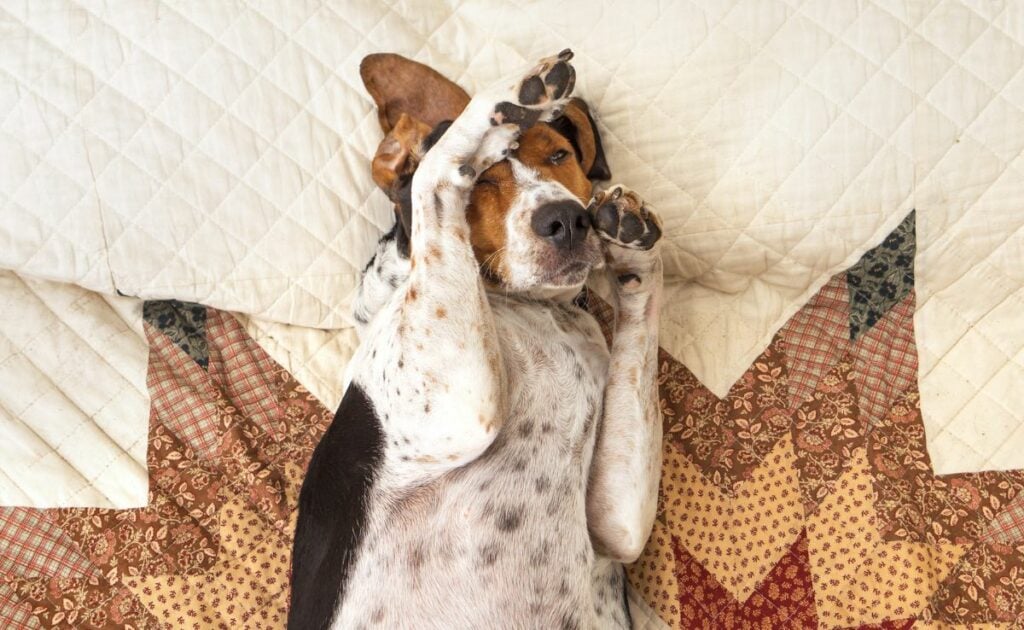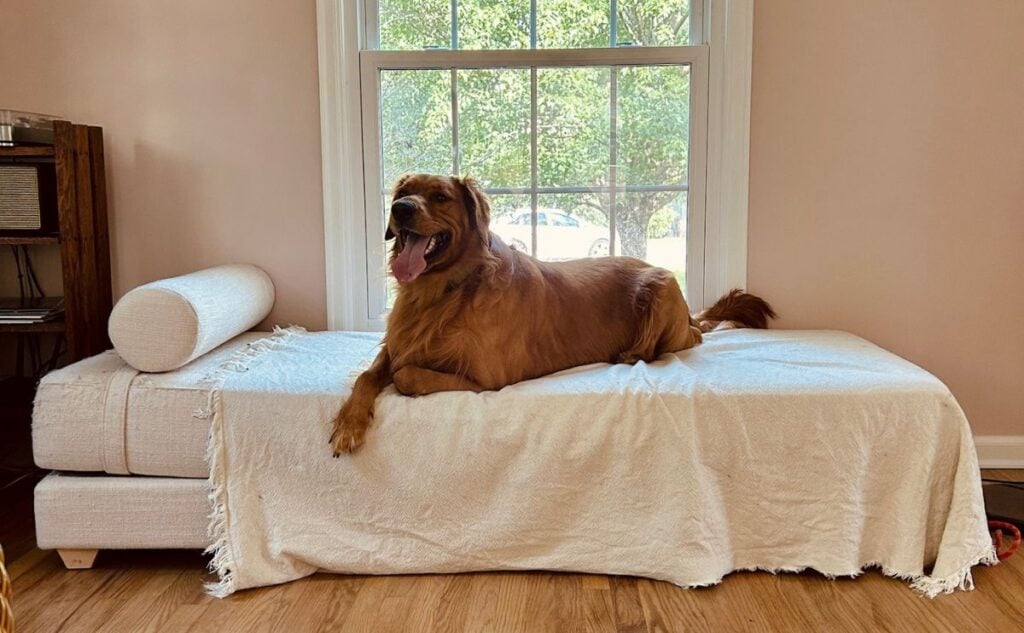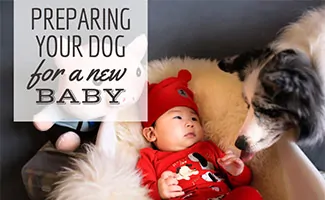Dog Sleeping in Bed? Here’s What You’re Really Sharing Your Sheets With
When you purchase through links on our site, we may earn a commission. Here’s how it works.
Your dog’s back on the bed, sprawled across your pillow like they own it. It’s cute… until the snoring, kicking, or suspicious damp spot shows up.
Table of Contents
So, should they even be there? Some experts argue that co-sleeping strengthens your bond. Others warn it messes with your sleep, your sheets, and your dog’s behavior.
If you’ve ever woken up clinging to the mattress edge while your dog lives like royalty, this is for you. Let’s break down the sweet, the gross, and the one co-sleeping mistake nearly every dog parent makes.
Your Dog Sleeps in Your Bed, But Should They?
Let’s get real: a lot of dog owners let their pup snuggle in bed with them. It feels comforting, bonding, even therapeutic. But is it actually good for you? Or your dog?

Recent research says… maybe yes. A sleep-tracking study found that people who slept with dogs had 81% sleep efficiency, meaning their rest wasn’t disrupted at all. In fact, some even fell asleep faster with their dog nearby.
According to another recent survey from the American Academy of Sleep Medicine, nearly half of Americans (46%) sleep with a pet in their bed.
And despite all the memes about dogs hogging the covers and cats claiming the pillows, only 19% say their sleep is worse because of it. Surprisingly, 46% say they actually sleep better with a furry friend next to them.
The trend is especially strong among younger people: 53% of Gen Z say they always, almost always, or sometimes co-sleep with a pet, compared to just 36% of Baby Boomers.
But it’s not all cuddles and oxytocin…
The Sweet Side:
- Boosts bonding and can reduce separation anxiety
- Releases oxytocin (the “cuddle chemical”) in both of you
- Can create bedtime routines and a sense of safety
The “Yikes” Side:
- Restless sleep from dog movement, snoring, or midnight zoomies
- Dirt, dander, allergens, and sometimes… other surprises
- Can reinforce clingy or possessive behavior, depending on the dog
Quick Takeaway: If your sleep’s solid and your dog’s healthy and well-behaved, co-sleeping might be totally fine. But if you’re waking up sweaty, squished, or sneezy, it might be time to rethink the bedtime arrangement.
Next up: What exactly is lurking in your sheets? (You may want to wash them after this.)
What’s Lurking in Your Sheets?
You love your dog. But your dog has been… places.
Rolling in the grass. Digging in the yard. Sniffing things you definitely wouldn’t put on your pillow. Now imagine all of that, quietly transferred into your sheets every night.

Here’s what you might be sharing your bed with when your dog hops up:
- Allergens – Pet dander, pollen, and dust stick to fur like Velcro
- Fleas or mites – Even indoor dogs can bring in bugs
- Bacteria – Think E. coli, Salmonella, or even Campylobacter
- Fur & oils – Triggers for anyone with allergies or asthma
- Outdoor grime – Mud, pesticides, road salt, mystery dirt, you name it
And yep, some dogs even bring in worms. Fleas can carry tapeworm eggs. You don’t want those on your sheets. Still feeling cozy?
Quick Tip: It’s crucial to wash your dog’s paws before bed and use washable, hypoallergenic bedding if you co-sleep.
Up next: Which dogs probably shouldn’t be in your bed at all?
Which Dogs Shouldn’t Sleep With You
Co-sleeping might be cozy, but for some dogs, it’s a definite “nope.”
Experts warn that not every dog is a good candidate for sharing your bed. In fact, for certain dogs, co-sleeping can worsen their behavior, spread illness, or significantly disrupt their sleep and yours.
Here’s when the experts say it’s time to draw the line:
- Puppies still potty training – Accidents + chewed pillows = disaster
- Dogs with fleas, worms, or skin infections – These can spread through bedding fast
- Resource guarders – Dogs who growl or snap if you move them
- Dogs with joint pain or arthritis – Jumping on/off beds can cause more harm
- Dogs with separation anxiety – Co-sleeping might reinforce clingy behavior
6 Considerations When Letting Your Dog Sleep In Your Bed
Before you invite your pup under the covers (or kick them out for good), here are a few key things to think about, including your health, your habits, and how your dog really behaves at night.
1. Your Dog’s Health
If your dog has painful arthritis or major joint issues, their body may need more support than your mattress can provide, especially if you like a softer bed.
Some dogs with musculoskeletal issues need firm support to ease their aches and pains. If this is the case with your pup, you may want to consider an orthopedic dog bed, which you can place on the floor near your bed.
Another issue to consider for older dogs is incontinence. As dogs age, their bladders become weaker and could leak when they lie down on your bed. Of course, you could always put pee pads down on your bed to keep your sheets dry if you still want your buddy in bed with you.
2. Your Dog’s Behavior
If your dog is aggressive and extremely territorial about their spaces, you may not want to introduce them into your bed. Dogs with these issues may bark and growl to protect their spot on your bed.
However, most well-adjusted and well-behaved dogs likely won’t exhibit these behaviors and will share your bed happily.
3. Your Allergies
Even if you don’t have an allergy to dog dander, other sensitivities can be triggered by co-sleeping with your furry friend. When dogs go outside, dust, pollen, and other irritants cling to their fur, and these can end up in your bed.
However, if allergies are a concern, it would be a good idea to run an air purifier and wipe your dog down with a damp towel or a bath wipe before bed.
4. Your Sleeping Habits
Are you a light or heavy sleeper? Does your dog move around a lot when they slumber? Your quality of sleep is one of the biggest concerns to think about. If you’re a light snoozer, your dog could disrupt getting a good night’s rest.
Many dogs want to lie very close to their pet parents, and their rolling over, kicking, or scratching could wake you up. And if your dog snores or dreams loudly, this could also pose a problem. Some owners train their dogs to sleep at their feet, so you could consider this option to help reduce disturbances.
5. A Sense Of Security
If you live alone, having your dog in bed with you can help you feel more secure. Many dog owners feel safer and rest better when snuggled up with their pups. Co-sleeping with your dog can ease anxiety because dogs are always on the alert if something goes bump in the night.
The close physical contact can also help relieve stress and even lower blood pressure levels. Dogs also make warm, cozy bedfellows.

Photo by Emma Braby for Canine Journal, © Cover Story Media, Inc. 2024.
I only let my two dogs, Bonkers and Chips, sleep in bed when my husband’s away, as it just makes me feel more secure. Knowing they’d alert me if something was wrong helps me relax.
But restful sleep? That’s another story. They take turns burrowing under the blanket, then flopping on top of it, every 30 minutes. One minute I’m roasting under fur, the next I’m blanket-less and wide awake. It’s not exactly a peaceful night, but honestly… it still feels worth it.
6. Bonding
If you’re not home most of the day for work or other reasons, spending quality time bonding with your dog is challenging, for sure. Sleeping together can be a great way for you and your dog to form a stronger bond.
Up next: the surprising emotional and scientific benefits of bedtime snuggles.
The Sweet Science of Snuggling (You’ll Love This)
Okay, I’ve talked germs and growls, but here’s why co-sleeping can be amazing (and why your dog loves it just as much as you do).
Cuddling with your dog triggers the release of oxytocin, the same feel-good hormone released when parents bond with babies. This isn’t just emotional fluff: studies show that dog–owner co-sleeping can:
- Lower heart rate and blood pressure
- Reduce cortisol (stress hormone) levels
- Create stronger emotional bonds between you and your pet
In one study, owners who co-slept with their dogs reported increased feelings of security, relaxation, and emotional support, especially those who lived alone.
And yes, your dog benefits too. Dogs are pack animals at heart, and sleeping close to you reinforces their trust and sense of safety. That’s why they often curl up near your chest or feet. They want to stay connected.
Fun fact: The University of Jyväskylä found that dogs who sleep with their owners have been shown to synchronize their sleep cycles and heart rate with their humans. Basically, they’re mirroring your bedtime routine, like the world’s cutest sleep buddy.
Up next: The one co-sleeping mistake almost everyone makes (and how to fix it before it becomes a problem).
The #1 Co-Sleeping Mistake Dog Owners Make
You’ve got the cuddles. The routine. The shared pillow. Everything seems perfect, until your dog starts growling when you roll over… or refuses to get off the bed when you ask.
Here’s the deal: the biggest co-sleeping mistake most dog parents make is not setting boundaries. Letting your dog sleep in your bed isn’t the problem, but treating it like their bed quickly becomes one.
Here are a few signs you’re crossing into problem territory:
- Your dog growls, stiffens, or resists being moved
- They jump up uninvited and refuse to get down
- They show signs of resource guarding (the bed = their territory)
- Your dog gets overly anxious when they don’t sleep in your bed

According to the American Kennel Club (AKC), when your dog sees the bed as theirs, not yours, it can feed into dominant or anxious behavior patterns.
Here are some easy fixes:
- Teach a release command like “off” or “place”
- Only allow them to come up by invitation, not by default
- Use a dog bed next to your bed for nights you need space
- Reinforce crate training or designated rest zones if needed
Dogs thrive on structure. Sharing your bed is fine, as long as it’s your bed, and they know it.
Next up: How to make co-sleeping more peaceful (for both of you).
6 Co-Sleeping Tips With Dogs
Love sleeping with your dog but hate waking up sweaty, squished, or sneezy? You’re not alone. The key isn’t kicking them out, it’s co-sleeping smarter.
Here’s how to reclaim your sleep without giving up the snuggles:
1. Use a Washable Duvet or Pet Blanket
Cover the area where your dog sleeps with a machine-washable throw or pet-specific blanket. It traps fur, drool, dirt, and mystery stains so your nice bedding stays fresh.
Wash it weekly, and keep a second on rotation.
2. Teach a Bedtime Command
Don’t let your dog make the rules. Training a consistent “up” and “off” command gives you control over when they’re allowed on the bed, and helps prevent behavioral issues like guarding.
Even cuddly dogs need boundaries to feel safe.
3. Switch to Allergy-Friendly Bedding
Dog dander + cotton sheets = sneeze city. Swap to hypoallergenic pillowcases, duvet covers, and mattress protectors to reduce allergen buildup. Look for tightly woven fabrics and breathable materials.
4. Create a “Dog Zone” on the Bed
Fold a small blanket or place a flat dog mat in a corner of the bed. This gives your pup a defined space, so they aren’t sprawled out sideways across your chest at 3 am.
Dogs love structure. And so does your spine.
5. Add Pet Ramps or Stairs
If your dog is small, aging, or has joint issues, jumping off a high bed can cause injury. Install soft-sided pet stairs or a bed ramp to make getting up and down safe and easy.
Plus, no more 2 am whining to get back up.
6. Try a Calming Bed Beside Yours
If your dog is extra clingy or you need a break, place a cozy orthopedic or calming dog bed next to your bed. It gives them the closeness they crave, without the snoring in your ear.
Many dogs will naturally transition to their own bed if it’s nearby.
Watch this TikTok of a Frenchie snoozing in a baby bassinet next to their mom’s bed, a hilarious (and genius) co-sleeping setup that keeps everyone comfy.
Quick Takeaway: You don’t have to choose between sleep and your dog. A few smart swaps can turn chaotic nights into comfy cuddles, with less fur in your mouth.
Should You Kick Them Out? Here’s the Middle Ground
So… should your dog sleep in your bed?
Here’s the truth: you don’t have to go all or nothing. There’s a middle ground that gives you the snuggles and the sleep, and it starts with setting smart boundaries and giving your dog their own cozy space.
Here are a few co-sleeping compromise ideas:
- Dog bed next to your bed: Perfect for dogs who just want to be close. You get space, they get comfort. Look for calming or orthopedic options that mimic the warmth of a bed.
- Co-sleeping on weekends only: Let your dog sleep with you as a treat, like a Saturday morning cuddle tradition. This keeps the novelty while preventing dependency.
- Crate in the bedroom: For dogs with anxiety or behavioral issues, a crate can offer structure and safety. Place their crate with a crate bed nearby so they still feel like part of the “pack.”
- Dog-friendly furniture alternative: Some owners use low futons, sofa beds, or even bassinets as dog sleep stations next to the main bed. It’s cute, and it works.
- Upgrade their bedding: If your dog still refuses to stay off your bed, try leveling up their setup. A plush, warm bed in a quiet, safe spot can be surprisingly effective, especially when paired with positive reinforcement.
Final word? If co-sleeping works for you and your dog, awesome. If it doesn’t, you’re not a bad pet parent for kicking them out. You’re just protecting your sleep, and theirs.
Our Team Weighs In On The Dog Sleeping In Bed Debate
I asked some of our team members about their sleeping habits with their dogs. Here’s what they shared.
In my house only small dogs are welcome on the bed. I have both large Lab mixes and smaller breed dogs. The big dogs are too hard on the furniture, but the little dogs love nothing more than cuddling up with us, wherever we are.
My small dogs are allowed to cuddle on the bed during the day, and sometimes even at night. However, they don’t sleep in human beds regularly.
Somehow these small dogs know how to take up all the space. It’s just not comfortable long term and I also worry about rolling over on the dogs. I’ve had dogs as small as 5 pounds, and have never been able to sleep well for fear they might get crushed.
– Danielle DeGroot, Dog Mom & Writer for Canine Journal

Photo by Tara Maurer for Canine Journal, © Cover Story Media, Inc. 2025.
When we first adopted Rio, he slept in the bedroom with us, and sometimes in the bed. That didn’t last long. He’s a total bed hog and has a habit of waking up too early, which meant none of us were sleeping well.
That said, the bed isn’t totally off limits. He’ll hop up during the day for a nap or to hang out while I’m reading or folding laundry.
As for keeping things clean, I wipe his paws after every walk using either paw wipes or a no-rinse foam cleanser. I wash the bedding weekly and run an air purifier in the bedroom to help with allergens and floating dog hair. Between that and regular vacuuming, it’s manageable.
– Tara Maurer, Dog Parent, Canine Journal Writer & Occasional Bed Space Negotiator
I think it should ultimately be up to the household. I don’t let my dog, Sally, in my bed. I don’t want to sleep in a bunch of dog hair, and there’s not enough room for her in it! However, if it were up to my husband, she’d be curled up in bed with us each night.
Instead, she has her own bed in our bedroom that she loves to curl up on. When she has sleepovers at my in-law’s home, they let her sleep in the bed with them, and she loves it.
The stories they have the next morning are always funny. She likes to sprawl out completely and press her paws up against their backs. I’m not sure how they sleep with her like that!
– Kimberly Alt, Dog Mom and Writer & Pet Insurance Expert for Canine Journal

Photo by Sadie Cornelius for Canine Journal, © Cover Story Media, Inc. 2024.
Our pup sleeps in bed with us, snuggled between the pillows and the headboard. She sleeps hard and doesn’t take up much space, so we don’t mind that she’s sharing the bed (except for the occasional, accidental kick in the face in the middle of the night when she’s chasing squirrels in her dreams).
Surprisingly, her snoring is soothing, and having her warmth and presence helps me sleep. We bathe her and clean our sheets regularly to minimize germs, spritz the bed with linen spray at night to keep them fresh, and we usually use a roller brush to pick up hair and debris from the pillows in the morning before making the bed.
She rarely needs to go out in the middle of the night (we take her right before bed and first thing in the morning, which helps).
– Sadie Cornelius, Dog Parent & Long-Time Friend of Canine Journal
Dog Sleeping In Bed FAQs
Here are some of the top questions our readers ask about sleeping with dogs. If you have one I haven’t listed below, ask us in the comments, and we’ll find the answer for you.
Does Co-Sleeping Create Dominance Issues?
Co-sleeping doesn’t create dominance issues. There is an old-school belief that dogs sleeping in human beds increases dominance problems. However, it sometimes reinforces the dominant behavior that is already there.
The thought behind this largely debunked theory is that dogs know you’re dominant because you tower over them when you’re upright. But if you’re both lying together on the same level, your dog can get confused about who’s the alpha. Most animal behaviorists these days disagree with this view.
Why Does My Dog Sleep So Close To Me (Or On Top Of Me)?
Canines are pack animals, and your dog considers you part of their pack. From birth, puppies have the instinct to feel comfort and security by being physically close to their littermates. This is why they pile on top of each other. And this packing instinct stays for life.
It’s not only a need for closeness and connection, but it’s also a sign of affection. Your dog staying so close to you is their way of telling you that they feel safe with you. Most dogs need this consistent closeness to feel happy and cared for.
How Do I Stop My Dog From Hogging The Bed?
Train your dog to sleep in a designated “bed zone” (corner, blanket, or mat), and use commands like “place.” If they sprawl or push, calmly guide them back. Don’t argue with a 60-pound blanket thief at 3 am, just redirect.
Can I Re-Train My Dog To Stop Sleeping In My Bed?
Yes, but consistency is key. Start by inviting them less often, introducing a comfy alternative (like a calming bed), and rewarding them for using it. Crate training or bedroom dog beds are great transitional options.
Is It Safe For Kids To Co-Sleep With Dogs?
In general, kids should not sleep with dogs. There’s a small risk of injury, even with friendly dogs, due to size, movement, or accidental aggression while startled. Always supervise and talk to your pediatrician or vet first.
What Does Your Dog’s Sleeping Position Reveal?
Your dog’s sleep position can say a lot about how they’re feeling. If they curl up like a donut, they’re likely seeking warmth and security. Sprawled on their side usually means they’re relaxed and feel safe. Belly-up with legs in the air? That’s a sign of total trust, and a clever way to cool down.
Dogs who sleep belly-down with legs stretched out (a “sploot”) are often playful and ready to pop up. And if your dog sleeps on top of you? That’s pure affection and bonding. Their body language is basically bedtime psychology.
Keep Your Dog Clean (Without Losing Your Mind)
Brushing your dog a few times a week helps reduce shedding and keeps their coat healthy. Most dogs only need a bath every 4 to 6 weeks, as any more than that can dry out their skin.
Look for a natural and gentle, pH-balanced dog shampoo that soothes the skin without harsh chemicals. And for in-between cleanups, a good dry shampoo can freshen them up without the mess of a full bath.
Tell Us: Does Your Dog Sleep in Your Bed? We want to hear your story! Does your pup snore like a freight train? Steal your pillow? Or have the perfect bedtime routine? Drop your funniest, weirdest, or sweetest co-sleeping moments in the comments. We might feature our favorites in an upcoming post!



